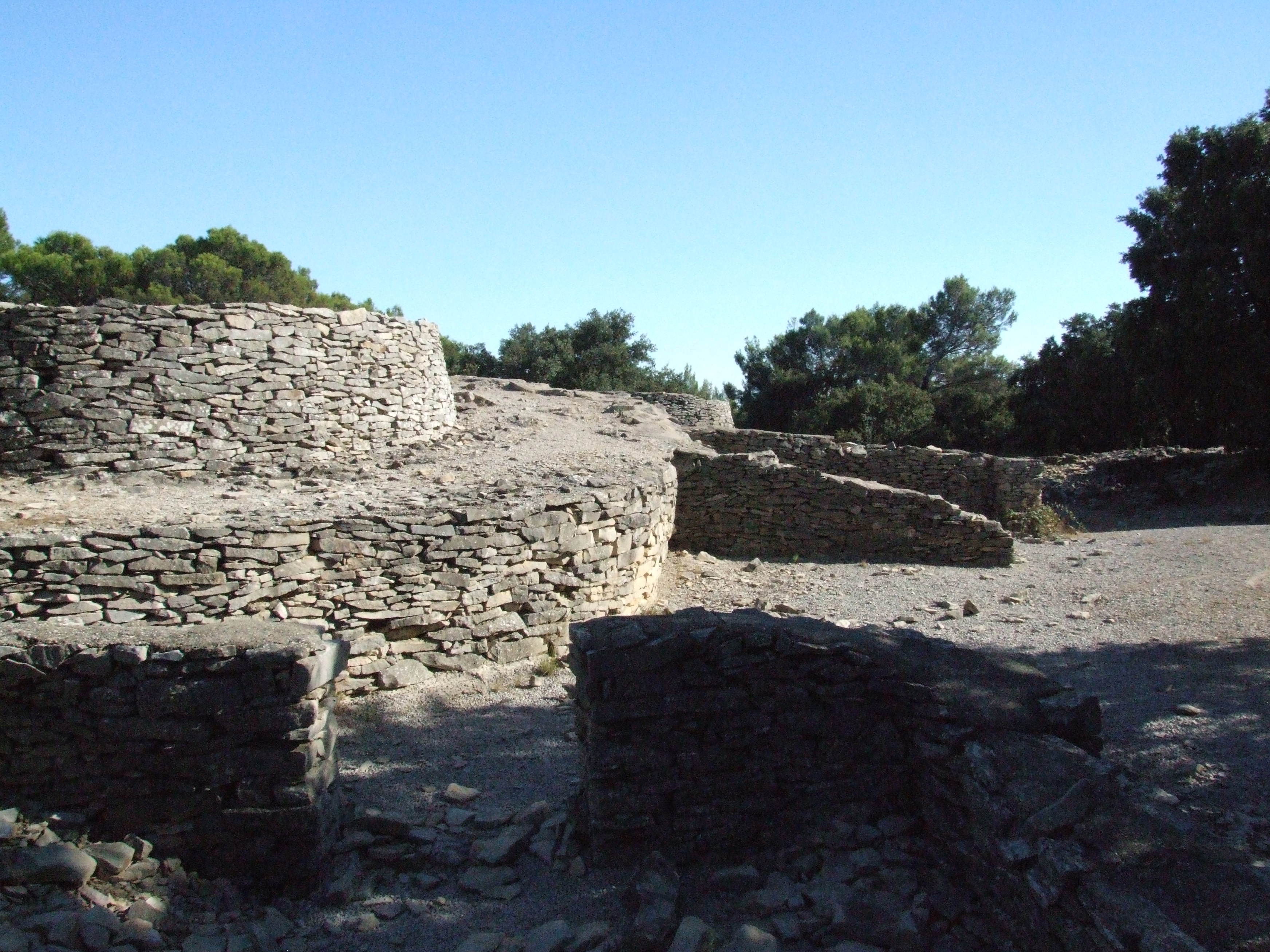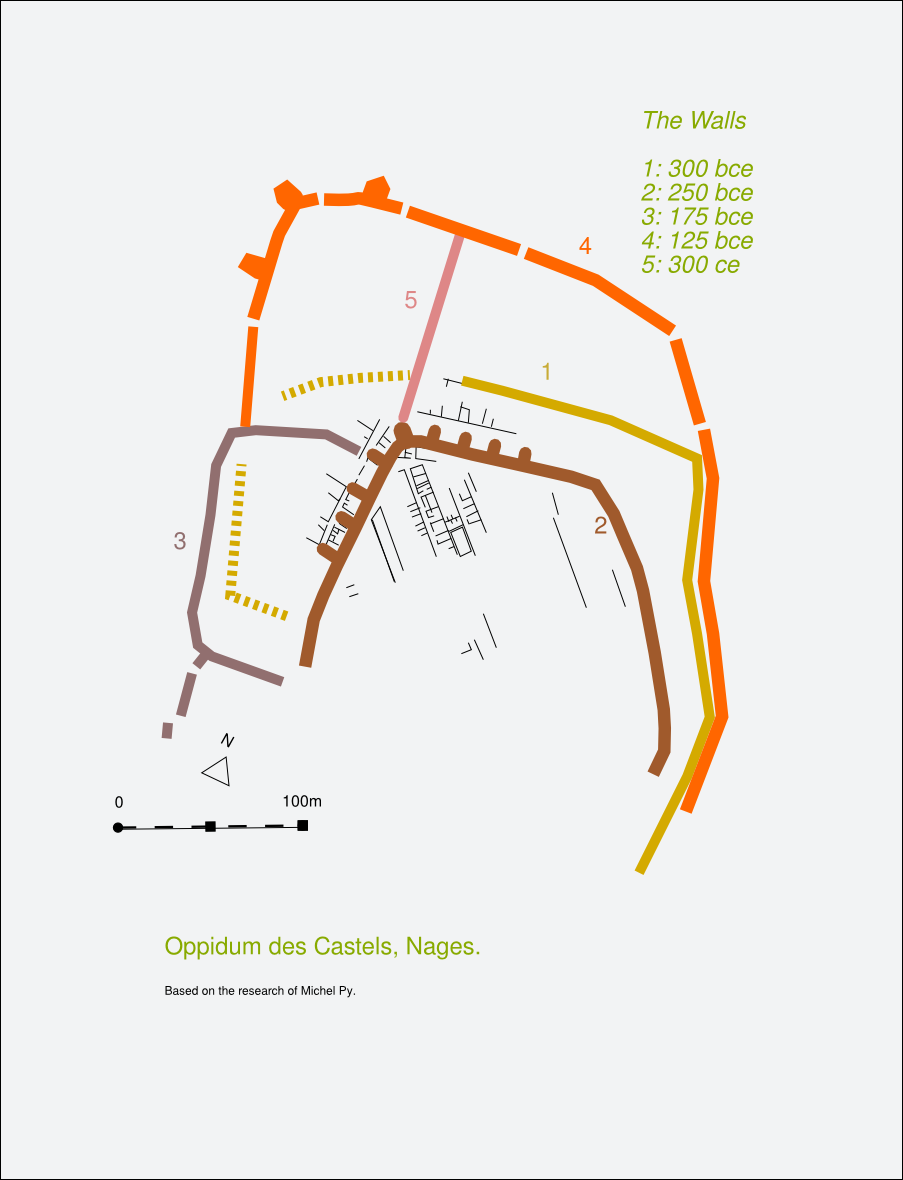Oppidum de Nages on:
[Wikipedia]
[Google]
[Amazon]
 The Oppidum de Nages or Oppidum des Castels is on a hilltop overlooking the valley called the
The Oppidum de Nages or Oppidum des Castels is on a hilltop overlooking the valley called the 
Les Dossiers de la Vaunage, archéologie et patrimoine
Oppidum: villes celtiques lors de la conquête de la Gaulle
Archaeological sites in France Buildings and structures in Gard Monuments historiques of Occitania (administrative region) Former populated places in France Tourist attractions in Gard {{France-hist-stub
Vaunage
The Vaunage is an area of southern France made up of the plain and the small hills around Nages, which is known for its Gallic oppidum. The Vaunage area is located between Languedoc and Provence and between Sommières and Nîmes. It is north of ...
, above the village of Nages-et-Solorgues
Nages-et-Solorgues (; oc, Najas e Solòrgues) is a commune in the Gard department in southern France.
Population
See also
*Communes of the Gard department
This is a list of the 351 communes of the Gard department of France.
The communes ...
, in Gard
Gard () is a department in Southern France, located in the region of Occitanie. It had a population of 748,437 as of 2019;Nîmes
Nîmes ( , ; oc, Nimes ; Latin: ''Nemausus'') is the prefecture of the Gard department in the Occitanie region of Southern France. Located between the Mediterranean Sea and Cévennes, the commune of Nîmes has an estimated population of 148,5 ...
et Sommières
Sommières (; oc, Someire) is a commune in the Gard department in southern France, located at the border with the Hérault department.
It lies from Nîmes, from Montpellier.
Geography
Sommières is to the south of the garrigues and on th ...
, in Occitanie Occitanie may refer to:
*Occitania, a region in southern France called ''Occitanie'' in French
*Occitania (administrative region)
Occitania ( ; french: Occitanie ; oc, Occitània ; ca, Occitània ) is the southernmost administrative region of ...
, France
France (), officially the French Republic ( ), is a country primarily located in Western Europe. It also comprises of Overseas France, overseas regions and territories in the Americas and the Atlantic Ocean, Atlantic, Pacific Ocean, Pac ...
. It is one of six iron-age
The Iron Age is the final epoch of the three-age division of the prehistory and protohistory of humanity. It was preceded by the Stone Age (Paleolithic, Mesolithic, Neolithic) and the Bronze Age (Chalcolithic). The concept has been mostly appl ...
oppida
An ''oppidum'' (plural ''oppida'') is a large fortified Iron Age settlement or town. ''Oppida'' are primarily associated with the Celtic late La Tène culture, emerging during the 2nd and 1st centuries BC, spread across Europe, stretchi ...
in the Vaunage, occupied between 800 BCE and 50 BCE. It has been listed since 1980 as a ''monument historique
''Monument historique'' () is a designation given to some national heritage sites in France. It may also refer to the state procedure in France by which National Heritage protection is extended to a building, a specific part of a building, a coll ...
'' by the French Ministry of Culture. Oppidum de Roque de Viou (également sur commune de Nages-et-Solorgues)

History
The name Vaunages is a contraction of "Vallée de Nages", the valley of Nages, which is a furrowedcombe
A combe (; also spelled coombe or coomb and, in place names, comb) can refer either to a steep, narrow valley, or to a small valley or large hollow on the side of a hill; in any case, it is often understood simply to mean a small valley through wh ...
at the edge of the garrigues plateau, surrounded by 200m-high hills that isolate it from the surroundings. There are two natural entrances, one to east coming from Nîmes
Nîmes ( , ; oc, Nimes ; Latin: ''Nemausus'') is the prefecture of the Gard department in the Occitanie region of Southern France. Located between the Mediterranean Sea and Cévennes, the commune of Nîmes has an estimated population of 148,5 ...
, and one to the south towards Vergèze
Vergèze (; oc, Vergesa) is a commune in the Gard department in southern France. Vergèze-Codognan station has rail connections to Nîmes, Avignon and Montpellier.
Located just south-east of the commune is the production facility for Perrier, ...
. As the name suggests Nages, and the hill behind play a dominant rôle in the area. There are hundreds of archaeological sites in the Vaunage. However it is the oppidum of Nages that has provided the richest archeological finds.
These valleys have been populated for over 2,000 years. Six ''oppida'', dominated by that at Nages, were home to the Volques Arécomiques, who built them in the 8th century BC and remained there till the 1st century AD :
* Oppidum de Nages in the commune of Nages-et-Solorgues
Nages-et-Solorgues (; oc, Najas e Solòrgues) is a commune in the Gard department in southern France.
Population
See also
*Communes of the Gard department
This is a list of the 351 communes of the Gard department of France.
The communes ...
;
* Oppidum de Roque de Viou
The Oppidum de Roque de Viou is on a hilltop overlooking the valley called the Vaunage, above the village of Nages-et-Solorgues, in Gard, between Nîmes et Sommières, in Occitanie, France. It is in the commune of Saint-Dionizy and is one of ...
, an earlier settlement in the commune of Saint-Dionizy but on the same ridge only some 200m away from the Oppidum de Nages
* Oppidum de la Liquière
An ''oppidum'' (plural ''oppida'') is a large fortified Iron Age settlement or town. ''Oppida'' are primarily associated with the Celtic late La Tène culture, emerging during the 2nd and 1st centuries BC, spread across Europe, stretch ...
, above the hamlet of Sinsans, in the commune of Calvisson
Calvisson (; Provençal: ''Cauviçon'') is a commune in the Gard department in the Occitanie region in southern France.
It lies between Nîmes, Montpellier, the Cevennes and the Camargue and has a strong Protestant history.
Geography
Calvis ...
;
* Oppidum de la Font du Coucou
An ''oppidum'' (plural ''oppida'') is a large fortified Iron Age settlement or town. ''Oppida'' are primarily associated with the Celtic late La Tène culture, emerging during the 2nd and 1st centuries BC, spread across Europe, stretch ...
above Calvisson ;
* Oppidum du Roc de Gachonne
An ''oppidum'' (plural ''oppida'') is a large fortified Iron Age settlement or town. ''Oppida'' are primarily associated with the Celtic late La Tène culture, emerging during the 2nd and 1st centuries BC, spread across Europe, stretchi ...
above Calvisson ;
* Oppidum de Mauressip
An ''oppidum'' (plural ''oppida'') is a large fortified Iron Age settlement or town. ''Oppida'' are primarily associated with the Celtic late La Tène culture, emerging during the 2nd and 1st centuries BC, spread across Europe, stretchi ...
or "Mouressipe", in the commune of Saint-Côme-et-Maruéjols
Saint-Côme-et-Maruéjols (; oc, Sent Còsme e Maruèjols) is a commune in the Gard department in southern France.
Population
See also
*Communes of the Gard department
This is a list of the 351 communes of the Gard department of France. ...
.
Archaeology
The site was excavated and then partially restored, between 1958 and 1974 by the French archaeologistMichel Py
Michel may refer to:
* Michel (name), a given name or surname of French origin (and list of people with the name)
* Míchel (nickname), a nickname (a list of people with the nickname, mainly Spanish footballers)
* Míchel (footballer, born 1963), ...
. Four stages of construction can be detected. The Volques first occupied the neighbouring Oppidum de Roque de Viou, then about 300 BCE moved into the larger Oppidum des Castel but abandoned it about 50 BCE moving into the Gallo-Roman settlement of Nemausis ( Nimes). The oppidium contained public buildings, roads, houses and shops a fanum
The vocabulary of ancient Roman religion was highly specialized. Its study affords important information about the religion, traditions and beliefs of the ancient Romans. This legacy is conspicuous in European cultural history in its influence on ...
(Gaulish temple).
References
Bibliography
*Michel Py, ''L'oppidum des Castels, à Nages (Gard)'', fouilles de 1958–1974, 35e supplément à Gallia, 1978, CNRS, Paris (355p.).External links
Les Dossiers de la Vaunage, archéologie et patrimoine
Oppidum: villes celtiques lors de la conquête de la Gaulle
Archaeological sites in France Buildings and structures in Gard Monuments historiques of Occitania (administrative region) Former populated places in France Tourist attractions in Gard {{France-hist-stub